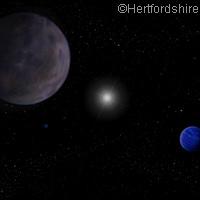Keeping up with our galactic neighbours: the nearby planetary system that might have more planets than us!
A European astronomer has just published new findings that show the planetary system around the star named HD 10180 may have more planets in its orbits than our own Solar System. At 130 light years away from Earth it would be impossible for humans to travel to the star, but in astronomical terms it is still considered to be a solar neighbour. Mikko Tuomi, an astronomer at the University of Hertfordshire in the United Kingdom, carried out his analysis as part of work being conducted in an EU-funded Marie Curie Initial Training Network (ITN) called 'Rocky Planets Around Cool Stars' (RoPACS) which is supported by EUR 3,211,716 of funding under the 'People' Theme of the EU's Seventh Framework Programme (FP7). Although astronomers originally thought HD 10180 was being orbited by 7 planets, after re-analysing data from HARPS (High Accuracy Radial Velocity Planet Searcher), a high-precision echelle spectrograph located on ESO's (European Southern Observatory) .6m telescope at the La Silla Observatory in Chile, it now seems that the star can actually boast to having 9 planets in its orbit. This discovery is significant as most planetary systems discovered so far have far fewer planets. Mikko Tuomi's study will soon be published in the journal Astronomy and Astrophysics, and as well as being the first evidence that two additional planets likely exist, his work also verifies the existence of the previously discovered seven planets. His findings suggest the 2 newly detected signals come from 2 planets classified as hot super-Earths with orbital periods around the star of 10 and 68 days. This means that these new planets are closer to the star's surface than the Earth is to the Sun which makes them too hot to be able to maintain water on their surfaces in its liquid form. They have masses of 1.9 and 5.1 times that of Earth which suggests that they are solid rocky bodies and make them among the smallest planets outside of our Solar System detected to date. Now further observations will be required to verify the existence of these potential new planets, and confirm whether the HD 10180 star system can indeed be heralded as the richest planetary system we know of. The main aim of the RoPACS network is to discover and study extra-solar planets that surround cool stars, by far the most common potential planet hosts. The network brings together astronomers from Germany, Spain, the Ukraine and the United Kingdom. By November 2012 when the RoPACS project comes to an end, the researchers involved hope to have found the answers to the following outstanding conundrums: how planet formation depends on the host star; the full range of stars around which habitable planets may be found; how our Solar System relates to the full diversity of planetary systems; and how we can best use future technology to discover and measure the full variety of potentially habitable extra-solar planets. The core principle of the network is to train early stage researchers (ESRs) and equip young experienced researchers (ERs) with astronomical, computational, mathematical and technical skills to measure, simulate and interpret scientific observations of extra-solar planets and the technologies used to observe and characterise them. It will also provide transferable skills such as multi-language programming, pipeline analysis techniques, the use of mathematical algorithms, spectroscopy, effective use of databases, engineering design techniques and education/outreach practices.For more information, please visit:University of Hertfordshire:http://www.herts.ac.uk/home-page.cfm
Countries
Germany, Spain, Ukraine, United Kingdom



